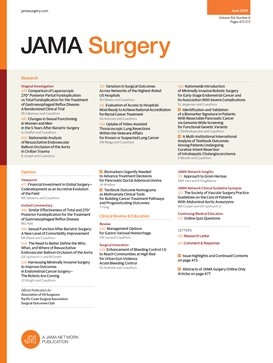择期腹疝修补术后需要移除补片感染的长期风险。
IF 14.9
1区 医学
Q1 SURGERY
引用次数: 0
摘要
每年有成千上万的人放置补片进行腹疝修补,但是需要移除补片的临床显著补片感染的长期风险仍然未知。目的探讨腹疝修补术后临床显著性补片感染需要移除的风险。设计、环境和参与者本回顾性队列研究纳入了2011年1月1日至2021年12月31日期间100%的医疗保险按服务收费行政索赔数据,这些数据来自于18岁或以上接受选择性开放式腹疝修补手术的住院患者。数据分析时间为2024年10月21日至2025年5月2日。腹疝修补术时放置的暴露网。主要结果和措施主要结果是指数手术后10年内的补片去除。目前的程序术语代码用于识别网状物移除,这被用作临床显著的网状物感染的替代措施。次要结果包括30天伤口并发症和随后的补片去除之间的关系。结果59 453例(女性35 209例[59.2%])中,1330例(2.2%)行补片取出术,取出补片的中位时间为8个月(238天;第25至75位位数= 49至757天= 2至25个月)。接受补片摘除的患者中女性多于未接受补片摘除的患者(63.0% [838]vs . 59.1%[34 371];P =。005),更常行肠切除术(3.5% [46]vs 2.3% [1342]; P =。008), 30天内出现伤口并发症的比例更高(23.6% [314]vs 6.6% [3825]; P < 0.001)。在10年随访中,有伤口并发症的患者去除补片的累积危险百分比为7.94 (95% CI, 7.03-8.84),而没有伤口并发症的患者为2.48 (95% CI, 2.31-2.64)。大多数补片移除发生在手术后的前5年内。结论和相关性这些研究结果表明,即使对有伤口并发症的人来说,补片移除的风险总体上是低的。这些发现支持补片在选择性腹疝开放性修补术中的广泛应用。本文章由计算机程序翻译,如有差异,请以英文原文为准。
Long-Term Risk of Mesh Infection Requiring Removal After Elective Ventral Hernia Repair.
Importance
Hundreds of thousands of people have mesh placed for ventral hernia repair every year, but the long-term risks of clinically significant mesh infection requiring mesh removal remain unknown.
Objective
To examine the risk of clinically significant mesh infection requiring removal after ventral hernia repair.
Design, Setting, and Participants
This retrospective cohort study included 100% Medicare fee-for-service administrative claims data from January 1, 2011, to December 31, 2021, for adults aged 18 years or older who underwent elective inpatient open ventral hernia repair with mesh. Data were analyzed from October 21, 2024, to May 2, 2025.
Exposure
Mesh placed at the time of ventral hernia repair.
Main Outcomes and Measures
The primary outcome was mesh removal up to 10 years after the index operation. Current Procedural Terminology codes were used to identify mesh removal, which was used as a surrogate measure for a clinically significant mesh infection. Secondary outcomes included the association between 30-day wound complications and subsequent mesh removal.
Results
Of 59 453 people (35 209 female [59.2%]), 1330 (2.2%) underwent mesh removal with a median time to mesh removal of 8 months (238 days; 25th to 75th percentile = 49 to 757 days = 2 to 25 months). People who underwent mesh removal were more often female than people who did not undergo mesh removal (63.0% [838] vs 59.1% [34 371]; P = .005), more often underwent enterectomy (3.5% [46] vs 2.3% [1342]; P = .008), and more often experienced a wound complication within 30 days (23.6% [314] vs 6.6% [3825]; P < .001). The cumulative hazard percentage of mesh removal for a patient with wound complications at 10-year follow-up was 7.94 (95% CI, 7.03-8.84) compared with 2.48 (95% CI, 2.31-2.64) for patients without. Most mesh removals occurred within the first 5 years after surgery.
Conclusions and Relevance
These findings suggest that the risk of mesh removal is low overall, even for people who experience a wound complication. These findings support the broad use of mesh for people undergoing elective open ventral hernia repair.
求助全文
通过发布文献求助,成功后即可免费获取论文全文。
去求助
来源期刊

JAMA surgery
SURGERY-
CiteScore
20.80
自引率
3.60%
发文量
400
期刊介绍:
JAMA Surgery, an international peer-reviewed journal established in 1920, is the official publication of the Association of VA Surgeons, the Pacific Coast Surgical Association, and the Surgical Outcomes Club.It is a proud member of the JAMA Network, a consortium of peer-reviewed general medical and specialty publications.
 求助内容:
求助内容: 应助结果提醒方式:
应助结果提醒方式:


